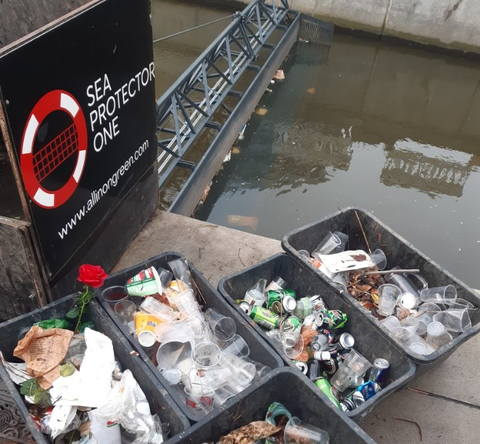VIBORG, Denmark--(BUSINESS WIRE)--At least 70 cities in Europe can now prevent huge amounts of waste from ending up in the sea. This has been demonstrated in the city of Aarhus in Denmark, where the robot SeaProtectorOne, made by All In On Green, collected over 100,000 pieces of waste from the city’s river in just 20 months. The technology thus shows how much pollution the city is otherwise sending into the marine environment.
Once waste enters the oceans, removing it is extremely difficult. This is why a Danish robotics invention is tackling the problem before it happens. The robot SeaProtectorOne is installed at the river mouth in Aarhus, where the river flows into the harbour and wider sea. The robot collects the waste—things like plastic cups, facemasks and pizza boxes—before it pollutes the sea. At the same time, it allows boats and other marine vessels to pass by.
SeaProtectorOne could also limit sea pollution from rivers in at least 70 other cities in Europe. This potential has been shown by thorough studies of the cities’ local conditions carried out by the team that has developed SeaProtectorOne. Kim Gulvad Svendsen, COO, Aarhus Municipality, readily shares his positive experience with this new weapon in the fight to prevent sea pollution.
“After the trial period, we were surprised at just how effective the robot was and by how much waste – especially plastic – it removed. This is plastic that will no longer end up in our marine environment. So the robot supports Aarhus Municipality’s sustainability efforts and above all, the UN’s global sustainable development goal no. 14: Life Below Water,” said Kim Gulvad Svendsen.
Every year, the amount of plastic waste that ends in the oceans is equivalent in weight to 57,000 blue whales. At least 90% of the plastic waste that floats around in the oceans, ends in the sea via river systems, according to the periodical Environmental Science.
“Once waste enters the sea it spreads quickly and is difficult to collect. Whereas the current in a river allows for the systematic filtering of waste in a limited area without disturbing fish or birds,” said Peter Grønkjær, Professor of Marine Biology at the Aarhus University.
Mads Tranders Nielsen from All In On Green is the man who invented SeaProtectorOne.
“In an ideal world, every citizen everywhere would learn to always put waste into a waste bin. But we don’t live in an ideal world. The idea for the robot came to me when I saw huge amounts of waste floating in a river in Melbourne. SeaProtectorOne has now shown its worth, even in Aarhus, one of Europe’s greenest cities. So, I’m looking forward to bringing this technology to the rest of the world for the benefit of the marine environment, fish and birds,” said Mads Tranders Nielsen from All In On Green.

